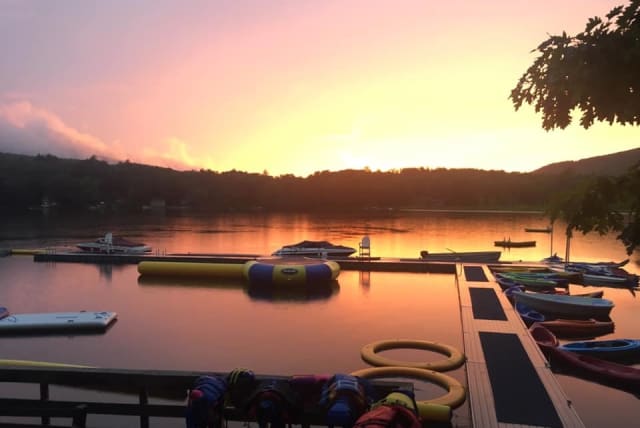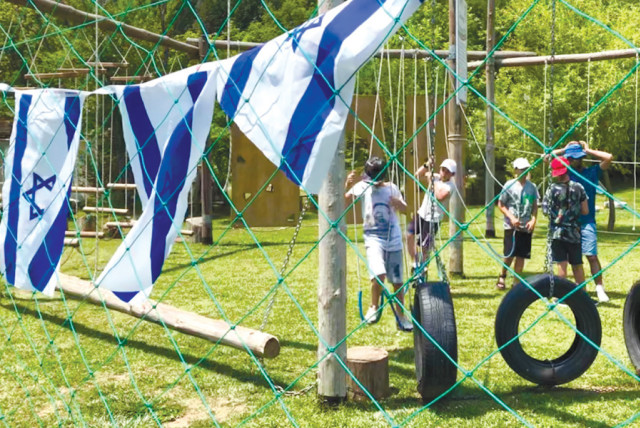How Jewish summer camp became a refuge for LGBTQ+ youth - opinion

Doing this work takes moving beyond polarized positions and opening ourselves up to the possibility that God’s image (and God for that matter) is much more varied than we ever imagined.
These past few weeks, many parents in my circle have been counting pairs of socks, labeling them with their kids’ names and packing duffle bags as they prepare to send their kids to summer camp. It’s an exciting week for parents and kids alike. This year, it’s also potentially lifesaving.
Saving a life is of the highest import in Jewish law, and that value — pikuah nefesh — makes breaking many other laws possible, even necessary, for the purpose of saving a life. This year, it is American law and the fear-based climate igniting new local and national campaigns targeting LGBTQ+ people, and particularly transgender youth, that is posing a significant threat to the wellbeing and lives of some Jewish teens.
Camp has always offered a refuge to teens. The Jewish community’s investment in Jewish summer camp is also an investment in people who are at the cutting edge of creating transformative, affirmative, creative Jewish spaces. LGBTQ+ and ally staff are using their creativity and passion to ensure that their institutions are vehicles for hatzalah — for saving lives and for the thriving of teens of all gender and sexual identities, and those still in the very developmentally appropriate process of experimenting and figuring out who they are and might be.
Last Sunday, I spent two hours as part of a Zoom training for counselors and camp professionals from Jewish summer camps from all over the country. Each of them will be running Moving Traditions’ Tzelem teen groups as an elective to provide LGBTQ+ teens with a dedicated safe, sacred space to explore and celebrate the various ways that Judaism and Jewish community can honor them as who they are — human beings created in the image of God, B’tzelem Elohim.
How to stay true to Jewish values amid challenging legislation
Among the things we discussed was how staff will have to navigate the intricacies of new legislation while also staying true to their ethics and values. At some camps, division heads and counselors — like school teachers in Florida — will have to engage in Talmudic-like legal contortions to inform trans campers that they see them but cannot call them by their pronouns without informing their parents because of the new laws. Camp leaders will also have to decide how to talk to campers — and to their often politically diverse parent bodies in ways that are educational, compassionate and clear, not an easy task in such a divisive, fear-fueled national climate.
I’m glad to say that this is happening, thanks to the many brave and committed Jewish educators and camp leaders who are answering this call. Eight years ago, I spearheaded the creation of Tzelem by Moving Traditions through a collaboration with Keshet. Moving Traditions already had a long history of running Rosh Hodesh groups for girls and Shevet for boys: transformative, small, mentor-led affinity groups that support teens to build resilience, a strong sense of self and the foundation of a life-long Jewish community. I believed that for some teens, a LGBTQ+ or specifically trans and non-binary affinity space and mentor would be the best way to ensure that the positive outcomes of Rosh Hodesh groups and Shevet were extending to LGBTQ+ teens as well.
The board and staff centered their educational work on the experience of listening and learning from non-binary, transgender and LGBQ+ youth. Doing this work takes moving beyond polarized positions and opening ourselves up to the possibility that God’s image (and God for that matter) is much more varied than we ever imagined.
Charles M. Blow wrote in the New York Times recently about the migration of LGBTQ kids and their families from states with discriminatory laws to states with protections — and the potential for more of these internal American political refugees. Jewish educators who work with Moving Traditions have been sharing their own painful decisions to move to protect their family members. As they move, they leave behind friends and family who can’t relocate and drain their communities of their talents and some of the amazing kids who used to be part of the tapestry of Jewish youth groups, Hebrew schools and friendship groups in the communities where they lived. Many Jews with their own ancestral trauma joke with one another about never setting down roots too strongly, that they keep one suitcase packed. But this isn’t a joke and it’s not the past — it’s real and it’s happening right now.
This is a moment of crisis to which the American Jewish community must respond with the same rigor and financial resources we would muster to help oppressed Jews anywhere else in the world. And we shouldn’t stop at helping Jews. Just as HIAS has for many years, we should extend our resources and expertise in resettlement beyond the oppressed of our own people. Did we ever imagine the refugees could be internally displaced Jewish families with transgender kids? I did not, but here we are.
One small way to start is to make sure that more Jewish summer camps can be temporary places of refuge. I’m deeply grateful that more camps are doing that this summer. But as trans and LGBTQ kids find freedom this summer, let’s work on ways to help them and their families protect their freedom throughout the year. Let’s work for the day when every state in the Union can be a safe haven for trans and nonbinary and all LGBTQ+ teens.
Jewish summer camps were created at a very different time in American Jewish history than the one we are living in now. They were an intervention often by Jews who had been in the United States longer and were more likely to have economic means — to give poorer, more recently immigrated Jews who lived in hot crowded city apartments an opportunity to send their kids to breathe fresh air, play on open fields and swim in lakes under the open sky. LGTBQ+ kids need not only fresh air to breathe, but the ability to be in communities where they can stop holding their breath, holding their fears quietly, where they can breathe easy knowing they belong and that they are recognized for who they are.
The views and opinions expressed in this article are those of the author and do not necessarily reflect the views of JTA or its parent company, 70 Faces Media.
Jerusalem Post Store
`; document.getElementById("linkPremium").innerHTML = cont; var divWithLink = document.getElementById("premium-link"); if (divWithLink !== null && divWithLink !== 'undefined') { divWithLink.style.border = "solid 1px #cb0f3e"; divWithLink.style.textAlign = "center"; divWithLink.style.marginBottom = "15px"; divWithLink.style.marginTop = "15px"; divWithLink.style.width = "100%"; divWithLink.style.backgroundColor = "#122952"; divWithLink.style.color = "#ffffff"; divWithLink.style.lineHeight = "1.5"; } } (function (v, i) { });

